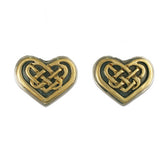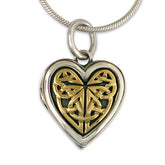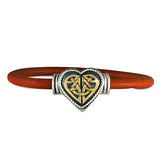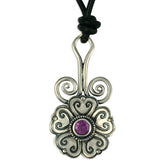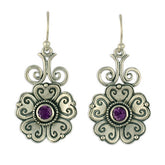The Celtic Cross
Emerging in roughly the 5th Century CE, the Celtic cross is an enduring symbol marking both cultural identity and religious faith. Adopted by Protestants and Catholics alike as a symbol of Christ-consciousness, the Celtic cross also has broad significance as a marker of cultural identity and heritage. Though legends abound concerning its origins, no factual historical record is available to place the Celtic cross in a specific time, location, or as originating from a particular craftsman.
The obscure origins of the Celtic cross match the universality of the symbol. Like other symbols that express something essential and cosmic about our human experience, it emerged mysteriously. What is known is that the Celtic cross has been the dominant religious and cultural symbol in the islands around Britain for centuries, capturing something unique to Celtic- influenced Christianity and culture.
There are two immediate distinctions in which the Celtic cross differs from the Latin cross. The first is the inclusion of knot work motifs. Knots are composed of geometric shapes which have deep symbolic significance. Flowing, elegant knot work is suggestive of plants and rivers. In the broadest sense, the knots themselves represent how all actions are interconnected in a great web of life. Archaeologists and art historians have long puzzled over the meaning of Celtic knot work, attempting to find a translation system so that various designs could be understood as having explicit meaning. The consensus among many academics now is that, if the designs ever did stand for something, that meaning has been lost.
The second distinction is the inclusion of the circle, centered on the intersection of the vertical and horizontal arms of the Latin Cross. Indeed, one of the most ancient and universal symbols in the history of the human race is a cross of equal arms inscribed in a circle. This figure, called a Solar Cross or Wheel Cross, is found in Paleolithic rock art around the world, and is clearly prehistoric. The Solar Cross is a symbol for the Sun, time and movement. The solstices and equinoxes mark the four parts of the solar year and the four directions.
Inevitably, when Romans brought the Christian symbol of the Latin Cross to the British Isles, the Celtic symbol for the Sun and the knot work motifs were fused with the new religion. The circle itself is one of the most visible blueprints in the universe, representing, among many thing, equality, boundaries and relationship to the whole. This fusion can be viewed as a redemption of pagan sun worship through the agency of Christianity, or an amplification of Christianity through the incorporation of pre- Christian symbols and beliefs.
The Latin Cross itself, with its vertical arm longer by roughly 1/3 than its horizontal arm, has both explicit and symbolic meaning. Explicitly, of course, the Latin Cross is a reminder of the crucifixion of Jesus, the sacrifice which for Christians marks the turning point of history. It also commemorates the event of the resurrection, the promise of eternal life made possible by the crucifixion.
More esoterically, the Latin Cross symbolizes the whole of Jesus' life, from incarnation to resurrection, as the union of the divine fused with vulnerable humanity. This is seen in the intersection of the vertical aspect, that which connects heaven and earth, and the horizontal aspect, the linearity of time's passage and the physical plane. Symbols with a strong vertical element suggest states of changeless being, and symbols with a horizontal aspect suggest the unfolding of time and the necessities of space.
The cross unifies the two fundamental states of being and becoming, although their intersection at right angles suggests ongoing tensions. The stress on the vertical direction perhaps displays the Christian emphasis on the ascent to heaven, in a direction away from earth and the profane. Yet the adoption of the Latin Cross as a symbol for Christianity also roughly corresponds to the ideal of human intelligence as the pinnacle of creation.
The Celtic cross places the ancient sun-symbol and intricate knot work elegantly around this point of intersection, as if to bring wholeness and a sense of resolution to the starkness of the Latin Cross. The divinity of the cosmos is included by this simple circle, and the idea of a unification of opposites in balance is conveyed. Sometimes seen as a halo, sometimes as the timelessness of eternal life, sometimes as an exaltation of ancient pagan symbolism, this circle and knot work adds mystery and beauty to a universal, numinous symbol.
Peter Breslin
* * * * * * *
Peter Breslin is a musician, astrologer, Tarot reader, teacher and freelance writer living in Santa Fe, New Mexico. He has taught mathematics, music, writing, and literature in the course of a 20-year teaching career in Pennsylvania, New York, New Mexico, and California. Writings include a variety of pieces for publications online and otherwise. He is currently at work on a novel.

